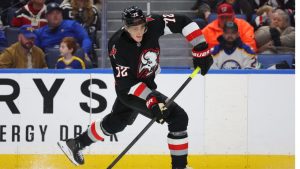BROSSARD, Que.— Let’s start with a text message from my brother, Michael, who was at last night’s game and shared the following opinion.
“Cole Caufield is actually underrated,” he wrote. “Not as a star or potential star, but his game is really well-rounded. His passing and playmaking ability are great and just being in the right place always. He’s like a firefly out there. Very, very quick.”
I don’t think it’s inaccurate to suggest Caufield’s overall game doesn’t get as much attention as his goal-scoring ability.
Considering the 21-year-old has scored 25 goals over his last 40 games, that’s going to suck up most the oxygen in the discussion around his game.
As for the description of Caufield as a firefly, it’s fitting. They’re small, and they light up for one-eighth of a second every six seconds and move in quick bursts. You see them in one spot and then, literally in a flash, they’ve distanced themselves from that spot.
Caufield’s doing that a lot more now than he did when he first arrived in Montreal as a 19-year-old and helped the Canadiens reach the 2021 Stanley Cup Final.
He’s a lot stronger now than he was then, and you can really see it in his skating.
I remarked to Caufield early in training camp that his stride appears more explosive than it was even last season, and he retorted, “Happy you noticed.”
Caufield said he put on five pounds of muscle over the off-season and did a lot of work in the gym specific to adding more pop to his skating stride. He added that he put more emphasis on his edge work in skating sessions.
It’s paid off, and not just in the goal-scoring department.
It’s a small sample, and I have to rely much more on the eye-test on this specific stat because I don’t feel it’s kept accurately by the NHL, but Caufield is proving really effective at forcing the other team into turnovers.
By the league’s kept stats, he’s averaging half a takeaway per game, which is seven per cent more than he did over 67 games last season and 20 per cent more than he did in the 10 games he played in the 2020-21 season. That he’s taking the puck away more at least jives with the eye test, which reveals he’s doing it more as the second forechecker.
About my doubt on the accuracy of these stats: It emanates from seeing something like Sean Monahan credited with five takeaways through four games and knowing that, by my count, he had four in the first game of the season.
I asked Rem Pitlick—who studies the game intensely whether he’s playing it or watching it, like he was as a healthy scratch the last two games—how many takeaways he thinks Monahan’s had this season, and he said, “A ton.”
“One of the first things I noticed about him in camp is how strong he is on his stick and how good of a stick he has,” Pitlick continued. “I’ve seen a ton in the games.”
I asked Monahan how many he thinks he has so far, and he said, “I don’t know, seven or eight?”
I told him he was credited with just one against the Maple Leafs in the season-opener, and he scoffed at that.
Good to know it’s not just me.
I digress.
Caufield, who has three goals already, is taking away the puck a lot more so far this season, and part of the reason he’s getting to these spots to get the puck back is his improved skating.
When we asked him after Monday’s game why he thinks he’s proving more effective at this, he had a simple answer that revealed another part.
“It’s our system,” Caufield said.
“And what’s your system? Enlighten me,” I responded.
“Making reads,” Caufield said.
His instincts are pretty sharp—another underrated aspect of his game.
Nick Suzuki says it’s that, and more.
“I think he reads the play really well, but he’s definitely done a better job of being more patient,” the Canadiens captain said after Tuesday’s practice. “He’s letting the play come to him instead of overreacting. He’s doing a good job of picking off passes and helping us stay in the offensive zone longer.”
That was most apparent in Monday’s win over the Pittsburgh Penguins.
Having Monahan join Caufield and Suzuki, who’s also very strong in taking away pucks, likely made it so.
As for Caufield’s passing and playmaking, we’ll try to dig into the data on his success rates for another piece.
But he certainly didn’t get enough credit for it last season, when he had 23 goals—and 20 assists to go with them.
The Canadiens generated a ton of it on Monday, and not just by taking away pucks—hey, at least they were credited with 12 takeaways in the game, which was closer to matching the eye-test.
They mostly did it by hanging onto pucks more, which was something coach Martin St. Louis asked them to do.
“I talked about taking care of the puck in the o-zone, not being one-and-done, not making hope plays,” St. Louis said. “But I was really happy about the first period because I felt that guys made a group decision that we were going to do that.”
There were many examples of it, but none better than the ones we saw from Brendan Gallagher throughout the night.
When I sat down with St. Louis last week for this interview, I asked him to identify one player who’s really taken the concepts he’s preaching and applied them well to improve his game.
St. Louis said it was Gallagher, who was “playing <i>the game </i> and not just his game.”
If you want tangible examples of that, go back and watch Gallagher’s shifts in Monday’s game.
I know you PVR’d it.
There were many instances where instead of driving straight through to the net or into the corner, Gallagher pulled up, waited for help, stickhandled, made a sharp pass or generated a good scoring chance.
On one play in the third period, he beat two guys with one dangle and got a good shot off that Casey DeSmith gloved down.
Gallagher finished with zero goals and zero assists, just like he did in the first three games of the season.
But he’s been effective in all four games the Canadiens have played. Ranking fourth on the team in individual fenwick and sixth in individual scoring chances is evidence.
A big part of that is how much more Gallagher is hanging onto pucks and not just making “hope plays.” If he keeps doing the same, he’s going to get his goals and assists.
After the Canadiens lost in Washington Saturday, I wrote all about how they want Juraj Slafkovsky to continue forming NHL habits—playing in straighter lines, using his body effectively, playing deeper in the offensive zone by not forcing plays on the rush.
On Monday, Slafkovsky did much more of all of that. As a result, the Canadiens controlled 69 per cent of the shot attempts when he was on the ice.
Slafkovsky’s line, with Mike Hoffman and Jake Evans, may not have played all that much.
But it was a huge part of the momentum the Canadiens generated throughout the game, and Evans said the 18-year-old’s contribution was the biggest reason for it.
“I think it was great the way he adjusted,” said Evans. “I think for him, in this league, he’s going to be annoying to play against and a very intimidating player to play against for a lot of D. I think he was great tonight with (playing more north-south and using his body). He was hitting, he was forechecking hard, keeping the puck, and I think that was the reason that our line had a pretty good night.”
St. Louis placing him on that line also allowed him to start a higher percentage of shifts in the offensive zone than he had in any other game so far.
The coach was also happy with what he saw from Slafkovsky on Monday.
“We talk daily with Slaf and we try to help him, and I really liked his game,” he said. “I thought he played a heavy game, he moved his feet. Obviously, with some of the special teams he doesn’t get to see a lot of the ice. But, like I said, they learn a lot from watching. But his 5-on-5 game I was pretty happy with.”






